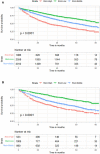A nomogram for predicting postoperative overall survival of patients with lung squamous cell carcinoma: A SEER-based study
- PMID: 37091268
- PMCID: PMC10118027
- DOI: 10.3389/fsurg.2023.1143035
A nomogram for predicting postoperative overall survival of patients with lung squamous cell carcinoma: A SEER-based study
Abstract
Background: Lung squamous cell carcinoma (LSCC) is a common subtype of non-small cell lung cancer. Our study aimed to construct and validate a nomogram for predicting overall survival (OS) for postoperative LSCC patients.
Methods: A total of 8,078 patients eligible for recruitment between 2010 and 2015 were selected from the Surveillance, Epidemiology, and End Results database. Study outcomes were 1-, 2- and 3-year OS. Analyses performed included univariate and multivariate Cox regression, receiver operating characteristic (ROC) curve construction, calibration plotting, decision curve analysis (DCA) and Kaplan-Meier survival plotting.
Results: Seven variables were selected to establish our predictive nomogram. Areas under the ROC curves were 0.658, 0.651 and 0.647 for the training cohort and 0.673, 0.667 and 0.658 for the validation cohort at 1-, 2- and 3-year time-points, respectively. Calibration curves confirmed satisfactory consistencies between nomogram-predicted and observed survival probabilities, while DCA confirmed significant clinical usefulness of our model. For risk stratification, patients were divided into three risk groups with significant differences in OS on Kaplan-Meier analysis (P < 0.001).
Conclusion: Here, we designed and validated a prognostic nomogram for OS in postoperative LSCC patients. Application of our model in the clinical setting may assist clinicians in evaluating patient prognosis and providing highly individualized therapy.
Keywords: end results (SEER); epidemiology; lung squamous cell carcinoma (LSCC); nomogram; prognosis; surgery; surveillance.
© 2023 Rao, Yu, Zhang, Wang, Wang and Wang.
Conflict of interest statement
The authors declare that the research was conducted in the absence of any commercial or financial relationships that could be construed as a potential conflict of interest.
Figures





Similar articles
-
Construction and Validation of a Novel Nomogram to Predict the Overall Survival of Patients With Combined Small Cell Lung Cancer: A Surveillance, Epidemiology, and End Results Population-Based Study.Cancer Control. 2021 Jan-Dec;28:10732748211051228. doi: 10.1177/10732748211051228. Cancer Control. 2021. PMID: 34632799 Free PMC article.
-
Nomogram predicting overall survival of rectal squamous cell carcinomas patients based on the SEER database: A population-based STROBE cohort study.Medicine (Baltimore). 2019 Nov;98(46):e17916. doi: 10.1097/MD.0000000000017916. Medicine (Baltimore). 2019. PMID: 31725640 Free PMC article.
-
Development and validation of a prognostic nomogram for predicting cancer-specific survival in patients with metastatic clear cell renal carcinoma: A study based on SEER database.Front Oncol. 2022 Sep 28;12:949058. doi: 10.3389/fonc.2022.949058. eCollection 2022. Front Oncol. 2022. PMID: 36237316 Free PMC article.
-
Development and validation of a dynamic survival nomogram for metastatic non-small cell lung cancer based on the SEER database and an external validation cohort.Transl Lung Cancer Res. 2022 Aug;11(8):1678-1691. doi: 10.21037/tlcr-22-544. Transl Lung Cancer Res. 2022. PMID: 36090634 Free PMC article.
-
A nomogram for predicting survival in Patients with oral tongue keratinized squamous cell carcinoma: A SEER-based study.J Stomatol Oral Maxillofac Surg. 2023 Sep;124(4):101422. doi: 10.1016/j.jormas.2023.101422. Epub 2023 Feb 11. J Stomatol Oral Maxillofac Surg. 2023. PMID: 36781109
Cited by
-
Prognostic factors and predictive models for patients with lung large cell neuroendocrine carcinoma: Based on SEER database.Clin Respir J. 2024 Apr;18(4):e13752. doi: 10.1111/crj.13752. Clin Respir J. 2024. PMID: 38606731 Free PMC article.
-
Survival benefit of postoperative chemotherapy in stage III lung squamous cell carcinoma based on SEER database analysis through propensity score matching.Sci Rep. 2025 Jul 1;15(1):22210. doi: 10.1038/s41598-025-07766-0. Sci Rep. 2025. PMID: 40596657 Free PMC article.
References
-
- Sculier JP. Management of resectable non-small cell lung cancer. Guidelines of clinical practice made by the European lung cancer working party. Rev Med Brux. (2014) 35(3):134–9. PMID: . - PubMed
LinkOut - more resources
Full Text Sources

